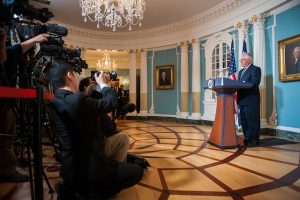
Secretary Tillerson Delivers Remarks on the 2016 International Religious Freedom Report. Photo: U.S Department of State
International Religious Freedom Annual Report 2016, the annual report from the United States Department of State was released on August 15. It details extensive restrictions on religious freedom in Tibet.
The report quotes the constitution of the People’s Republic of China which states that citizens “enjoy freedom of religious belief” butlimits protections for religious practice to “normal religious activities” without defining “normal.” The report continues: “In the TAR and other Tibetan areas, authorities engaged in widespread interference in religious practices, especially in Tibetan Buddhist monasteries and nunneries. There were reports of forced disappearance, physical abuse, prolonged detention without trial, and arrests of individuals due to their religious practices. Travel restrictions hindered traditional religious practices and pilgrimages. Repression increased around politically sensitive events, religious anniversaries, and the Dalai Lama’s birthday, according to numerous sources. Although the number of self-immolations has continued to decline, there were three cases of self-immolation and three other suicides in protest of government policies. Reportedly, authorities evicted more than 2,000 monks and nuns from Buddhist institutes at Larung Gar and Yachen Gar, destroying the homes where they resided and subjecting many of them to ‘patriotic re-education’. The government routinely denigrated the Dalai Lama, whom most Tibetan Buddhists revere as their most important spiritual leader, and forbade Tibetans from venerating him and other religious leaders associated with him. Authorities often justified their interference with Tibetan Buddhist monasteries by claiming they engaged in separatist or pro-independence activities.
“Some Tibetans encountered societal discrimination when seeking employment, engaging in business, or when traveling, according to multiple sources”.
The report goes on to say that the US government has repeatedly pressed the Chinese authorities to “respect religious freedom for all faiths and to allow Tibetans to preserve, practice, teach, and develop their religious traditions and language”.
It mentions the meeting between the then President Obama and His Holiness the Dalai Lama in June last year, saying that Obama emphasised the “strong support of the United States for the preservation of Tibet’s traditions and heritage and the equal protection of Tibetan human rights in China”. It continues by mentioning that the Secretary of State has, in his visits to China, consistently raised the issue of Tibet and called for the protection of human rights in Tibetan regions.
The report states that the US recognises Tibet as part of China.
The report gives details on the status of religious freedom in 199 countries and territories. Secretary of State Rex Tillerson said on the report’s release, “No one should have to live in fear, worship in secret, or face discrimination because of his or her beliefs […] the State Department will continue to advocate on behalf of those seeking to live their lives according to their faith.”




 Print
Print Email
Email